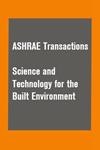Tube Bundle Evaporators with LGWP Refrigerant R1234ze(E)
IF 1.7
4区 工程技术
Q3 CONSTRUCTION & BUILDING TECHNOLOGY
Science and Technology for the Built Environment
Pub Date : 2023-10-26
DOI:10.1080/23744731.2023.2276010
引用次数: 0
Abstract
AbstractWith new low-GWP HFO refrigerants, the heat transfer performances and methods for decreasing system refrigerant inventory are receiving increasing interest. In shell-and-tube heat exchangers, refrigerant distribution via pressurized liquid spray has the potential for high heat transfer performance while reducing refrigerant charge. However, no published studies have investigated LGWP refrigerants with spray evaporation on tube bundles. A test apparatus was constructed to measure the shell-side heat transfer coefficients of R1234ze(E) on bundles of tubes with two different enhanced-surface types and in two different bundle geometries at various refrigerant saturation temperatures. The results showed strong dependence on refrigerant properties, tube heat flux, enhanced-surface type, bundle geometry, and refrigerant inlet subcooling. The bundle heat transfer coefficients of R1234ze(E) were similar to that of R134a in the same test setup, usually within ±15% for similar conditions. In both cases, they first increased with the heat flux until a local maximum value was achieved. A localized dryout of the tubes at the bottom of the bundle penalized the overall bundle heat transfer coefficient at very high heat flux. For the condensing surface, bundle heat transfer coefficients rarely exceeded 10 kW/m2-K, whereas values in excess of 30 kW/m2-K were sometimes seen for the evaporating surface.Keywords: LGWP refrigerantsspray evaporationenhanced surfacestube bundlesSubject classification codes: include these here if the journal requires themDisclaimerAs a service to authors and researchers we are providing this version of an accepted manuscript (AM). Copyediting, typesetting, and review of the resulting proofs will be undertaken on this manuscript before final publication of the Version of Record (VoR). During production and pre-press, errors may be discovered which could affect the content, and all legal disclaimers that apply to the journal relate to these versions also.LGWP制冷剂R1234ze(E)管束式蒸发器
摘要随着新型低gwp HFO制冷剂的出现,系统制冷剂的传热性能和减少系统制冷剂库存的方法受到越来越多的关注。在管壳式换热器中,制冷剂通过加压液体喷雾分布,在减少制冷剂充注量的同时具有较高的传热性能。然而,目前还没有发表的关于液冷潜能值制冷剂在管束上喷雾蒸发的研究。搭建了R1234ze(E)在不同制冷剂饱和温度下两种不同强化表面类型和两种不同管束几何形状的管束上的壳侧换热系数测试装置。结果表明,制冷剂性能、管热流密度、强化表面类型、束状几何形状和制冷剂进口过冷程度都有很强的依赖性。在相同的试验装置下,R1234ze(E)的束传热系数与R134a相似,在相同的条件下通常在±15%以内。在这两种情况下,它们首先随热通量增加,直到达到局部最大值。在非常高的热流密度下,管束底部的管的局部干燥对整个管束的传热系数不利。对于冷凝面,束传热系数很少超过10 kW/m2-K,而蒸发面有时会超过30 kW/m2-K。关键词:LGWP制冷剂;喷雾蒸发;增强表面;管束;主题分类代码:如果期刊需要,在这里包括它们免责声明作为对作者和研究人员的服务,我们提供这个版本的已接受手稿(AM)。在最终出版版本记录(VoR)之前,将对该手稿进行编辑、排版和审查。在制作和印前,可能会发现可能影响内容的错误,所有适用于期刊的法律免责声明也与这些版本有关。
本文章由计算机程序翻译,如有差异,请以英文原文为准。
求助全文
约1分钟内获得全文
求助全文
来源期刊

Science and Technology for the Built Environment
THERMODYNAMICSCONSTRUCTION & BUILDING TECH-CONSTRUCTION & BUILDING TECHNOLOGY
CiteScore
4.30
自引率
5.30%
发文量
78
期刊介绍:
Science and Technology for the Built Environment (formerly HVAC&R Research) is ASHRAE’s archival research publication, offering comprehensive reporting of original research in science and technology related to the stationary and mobile built environment, including indoor environmental quality, thermodynamic and energy system dynamics, materials properties, refrigerants, renewable and traditional energy systems and related processes and concepts, integrated built environmental system design approaches and tools, simulation approaches and algorithms, building enclosure assemblies, and systems for minimizing and regulating space heating and cooling modes. The journal features review articles that critically assess existing literature and point out future research directions.
 求助内容:
求助内容: 应助结果提醒方式:
应助结果提醒方式:


